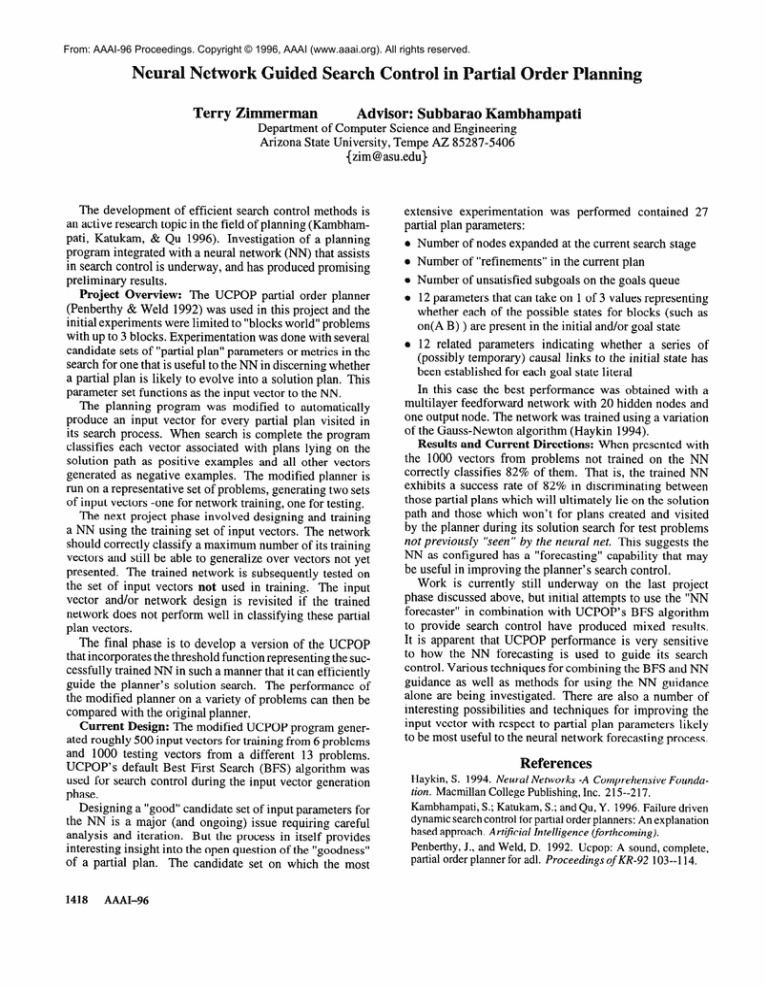
From: AAAI-96 Proceedings. Copyright © 1996, AAAI (www.aaai.org). All rights reserved.
1 Order Plan
Neural Network Gui
Terry
Zi
erman
Advisor: Subbarao Kambhampati
Department of Computer Science and Engineering
Arizona State University, Tempe AZ 85287-5406
(zim@asu.edu)
The development of efficient search control methods is
an active research topic in the field of planning (Kambhampati, Katukam, & Qu 1996). Investigation of a planning
program integrated with a neural network (NN) that assists
in search control is underway, and has produced promising
preliminary results.
Project Overview: The UCPOP partial order planner
(Penberthy & Weld 1992) was used in this project and the
initial experiments were limited to “blocks world” problems
with up to 3 blocks. Experimentation
was done with several
candidate sets of “partial plan” parameters or metrics in the
search for one that is useful to the NN in discerning whether
a partial plan is likely to evolve into a solution plan. This
parameter set functions as the input vector to the NN.
The planning program was modified to automatically
produce an input vector for every partial plan visited in
its search process. When search is complete the program
classifies each vector associated with plans lying on the
solution path as positive examples and all other vectors
generated as negative examples. The modified planner is
run on a representative set of problems, generating two sets
of input vectors -one for network training, one for testing.
The next project phase involved designing and training
a NN using the training set of input vectors. The network
should correctly classify a maximum number of its training
vectors and still be able to generalize over vectors not yet
presented. The trained network is subsequently tested on
The input
the set of input vectors not used in training.
vector and/or network design is revisited if the trained
network does not perform well in classifying these partial
plan vectors.
The final phase is to develop a version of the UCPOP
that incorporates the threshold function representing the successfully trained NN in such a manner that it can efficiently
guide the planner’s solution search. The performance of
the modified planner on a variety of problems can then be
compared with the original planner.
Current Design: The modified UCPOP program generated roughly 500 input vectors for training from 6 problems
and 1000 testing vectors from a different 13 problems.
UCPOP’s default Best First Search (BFS) algorithm was
used for search control during the input vector generation
phase.
Designing a “good” candidate set of input parameters for
the NN is a major (and ongoing) issue requiring careful
analysis and iteration. But the process in itself provides
interesting insight into the open question of the “goodness”
of a partial plan. The candidate set on which the most
1418
AA41-96
extensive experimentation
partial plan parameters:
was performed
contained
27
Number of nodes expanded at the current search stage
Number of “refinements”
Number of unsatisfied
in the current plan
subgoals on the goals queue
12 parameters that can take on 1 of 3 values representing
whether each of the possible states for blocks (such as
on(A B) ) are present in the initial and/or goal state
12 related parameters indicating whether a series of
(possibly temporary) causal links to the initial state has
been established for each goal state literal
In this case the best performance was obtained with a
multilayer feedforward network with 20 hidden nodes and
one output node. The network was trained using a variation
of the Gauss-Newton algorithm (Haykin 1994).
Results and Current Directions: When presented with
the 1000 vectors from problems not trained on the NN
correctly classifies 82% of them. That is, the trained NN
exhibits a success rate of 82% in discriminating
between
those partial plans which will ultimately lie on the solution
path and those which won’t for plans created and visited
by the planner during its solution search for test problems
not previously “seen” by the neural net. This suggests the
NN as configured has a “forecasting” capability that may
be useful in improving the planner’s search control.
Work is currently still underway on the last project
phase discussed above, but initial attempts to use the “NN
forecaster” in combination with UCPOP’s BFS algorithm
to provide search control have produced mixed results.
It is apparent that UCPOP performance is very sensitive
to how the NN forecasting is used to guide its search
control. Various techniques for combining the BFS and NN
guidance as well as methods for using the NN guidance
alone are being investigated.
There are also a number of
interesting possibilities and techniques for improving the
input vector with respect to partial plan parameters likely
to be most useful to the neural network forecasting process.
References
Haykin, S. 1994. Neural Networks -A Comprehensive Foundation. Macmillan College Publishing, Inc. 2 15-2 17.
Kambhampati, S.; Katukam, S.; and Qu, Y. 1996. Failure driven
dynamic search control for partial order planners: An explanation
based approach. Artificial Intelligence (forthcoming).
Penberthy, J., and Weld, D. 1992. Ucpop: A sound, complete,
partial order planner for adl. Proceedings of KR-92 103-- 114.


